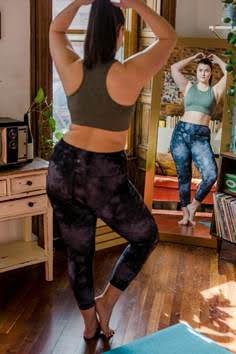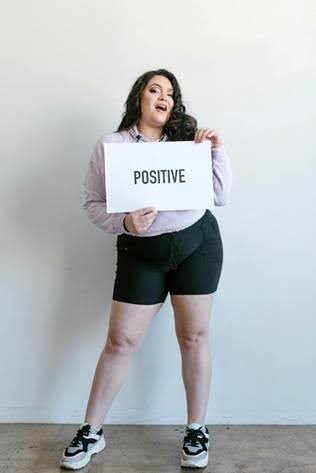You’re in a fitting room. The lighting’s harsh. Three sizes of the same jeans hang on the hook because no two brands seem to agree. You pull one pair up, too tight. The next feels baggy. You sigh, stare at the tag, and feel the familiar knot in your stomach.
That small square of fabric suddenly influences our self-worth more than it was ever meant to.
Your size tag is a system label, not a value statement. But for most of us, the number on that tag has become shorthand for how ‘good’ or ‘bad’ we’re allowed to feel about ourselves that day.
Why This Happens to Us
Our brains love numbers. They’re tidy. They offer control in a world full of uncertainty. Psychologists call this a heuristic: a mental shortcut we use to make sense of complex things.
Numbers feel concrete. Emotions don’t. So, when life feels messy, the brain grabs for measurable cues like weight, size, or calories. It’s not vanity. In fact, it’s how we’re wired.
Research on contingencies of self-worth shows that when we tie our value to appearance, our self-esteem becomes fragile. It rises and falls with every compliment, mirror check, and tag we read.
And it doesn’t stop there. Objectification theory explains that constant body monitoring, checking, comparing, adjusting, keeps us trapped in self-consciousness and body shame. No wonder we can’t think clearly when clothes don’t fit; our nervous system reads it as a threat.
The real problem isn’t the size itself. It’s the story we’ve attached to it.
How It Shows Up in Our Daily Life

You might recognise it in the small, almost invisible moments.
- Keeping ‘goal jeans’ in your closet as proof of progress, or punishment.
- Cancelling plans because your outfit didn’t fit the way it used to.
- Letting a number decide whether you’ve been ‘good’ or ‘bad’ that week.
For others, it shows up differently. Buying clothes only after weight loss. Punishing workouts after seeing a bigger tag. A closet full of ‘someday’ items that whisper you’re still not there yet.
Language gives it away too: ‘I was good when I fit the 8,’ or ‘I blew it, I’m a 14 again.’
It’s the quiet, relentless measuring that drains joy from something as simple as getting dressed.
The Emotional and Physical Cost on Us
The more power we give those numbers, the more they shrink the rest of our lives.
It starts subtly: your mood dips, you skip the photo, you pass on the dinner invite. Over time, it builds into self-doubt, body monitoring, and a kind of mental white noise that follows you everywhere.
Physically, the stress response kicks in. Your heart rate climbs. Cortisol rises. You tense your jaw, your shoulders, your stomach. Chronic stress makes it harder to feel safe in your own body, and safety is the foundation of confidence.
It doesn’t stop with you, either. When kids or partners see us grimacing in the mirror or tugging at our clothes, they learn the same equation: appearance equals worth.
And that’s what we have the power to break.
Why We Need to Change This Pattern
When your worth is linked to size, the finish line keeps moving. You reach one goal only to shift the target. Satisfaction lasts minutes before the next ‘if only’ takes over.
True confidence doesn’t live in a mirror. It lives in how you treat yourself. It’s a relationship skill, not a number.
What if the goal wasn’t to fit into a smaller tag, but to feel comfortable, grounded, and self-respecting in the body you have today?
How to Start Rewriting the Script

1. Shift the Mindset
Fit over figure. Clothes are meant to fit you. Not the other way around. When something doesn’t zip, it’s a design issue, not a personal flaw.
Neutral language. Try replacing ‘I’m a size 14’ with ‘This brand’s 14 fits like my 10 elsewhere.’ It’s not denial. That’s accuracy.
Anchor your worth elsewhere. Write down five traits that have nothing to do with appearance: kindness, creativity, humour, courage, and consistency. These are the qualities that stay steady no matter what the scale or label says.
2. Practical Actions That Build Body Confidence
Try clothes size-agnostically. Bring three sizes into the fitting room. Cover the tags with sticky notes. Move, sit, and breathe in each one. Pick what feels comfortable, not what matches a mental benchmark.
Do a 30-minute closet reset.
- Pull out anything that pinches, rides up, or requires ‘sucking in.’
- Keep what fits your life now, soft, breathable, forgiving.
- Box ‘comparison clothes’ for 90 days. Revisit them later without judgment.
Rehearse your body-kind shopping script:
- Before: ‘My worth isn’t up for negotiation.’
- During: ‘Sizing is a brand code, not a verdict.’
- After: ‘Comfort equals energy. Energy fuels my life.’
Use the body as an ally. When tension hits, place a hand on your waist or chest. Inhale for four, exhale for six. Notice the waistband easing instead of digging. Let your body register safety again.
Small compassion reps. Be honest with yourself and admit that you feel uncomfortable but take steps to respond with care. The goal isn’t to love every part instantly. The goal is to stop waging war on them.
3. Gentle Experiments
The Tag Tape Challenge (7 Days). Cover every size tag you can find. Notice how your mood changes when there’s no number to interpret.
Mirror cue. Each morning, place your hand on your heart or stomach and say, ‘Thank you for carrying me.’ It rewires focus from critique to gratitude. Confidence ledger. Keep one small promise a day: a glass of water, a stretch, or an early night. Each tick rebuilds trust that you follow through, which strengthens self-worth more than any diet or dress ever could.
Explore What’s Shaping Your Self-Worth
Labels help stores, not humans. Your body isn’t a problem to solve, and your worth isn’t a size to reach. The number inside your jeans can’t tell the story of your resilience, humour, empathy, or strength.
The next time a tag threatens to dictate your mood, pause. Feel your breath. Remind yourself: Numbers measure fabric, not value. Start where you are, with comfort, compassion, and the quiet decision to treat yourself as someone already enough.
Ready to explore what’s been shaping your self-worth? Take the Body Confidence Quiz to uncover your patterns and first steps toward change. Or visit natalietrusdale.com for more free tools and coaching support.
xxx

Hey I’m Natalie, Supporting women like you on their road to self-acceptance and building a positive body image.

View comments
+ Leave a comment